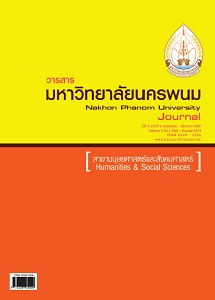การเปรียบเทียบผลสัมฤทธิ์ทางการเรียนและความสามารถในการคิดวิเคราะห์ เรื่อง ความปลอดภัยในชีวิต ของนักเรียนชั้นประถมศึกษาปีที่ 6 ระหว่าง การจัดกิจกรรมการเรียนรู้แบบ 4 MAT และแบบโครงงาน
Main Article Content
Abstract
การวิจัยครั้งนี้มีวัตถุประสงค์เพื่อ 1) เปรียบเทียบผลสัมฤทธิ์ทางการเรียนระหว่างนักเรียนที่เรียนด้วยการจัดกิจกรรมการเรียนรู้ แบบ 4 MAT และแบบโครงงาน 2) เปรียบเทียบความสามารถในการคิดวิเคราะห์ 3) ศึกษาความพึงพอใจต่อการจัดกิจกรรมการเรียนรู้ กลุ่มเป้าหมาย ได้แก่ นักเรียนชั้นประถมศึกษาปีที่ 6 โรงเรียนบ้านหนองเทา ภาคเรียนที่ 1 ปีการศึกษา 2555 จำนวน 2 ห้อง ซึ่งได้มา โดยการเลือกแบบเจาะจงและสุ่มวิธีสอน ได้นักเรียนห้อง 6/1 จำนวน 23 คน สอนโดยกิจกรรมการเรียนรู้ 4 MAT และ นักเรียนห้อง 6/2 จำนวน 24 คน สอนโดยกิจกรรมการเรียนรู้แบบโครงงาน เครื่องมือที่ใช้ในการวิจัย ได้แก่ 1) แผนการจัดกิจกรรมการเรียนรู้แบบ 4 MAT และแบบโครงงาน รูปแบบละ 6 แผนๆ ละ 2 ชั่วโมง 2) แบบทดสอบผลสัมฤทธิ์ทางการเรียน จำนวน 40 ข้อ ซึ่งมีค่าความยาก รายข้อ ตั้งแต่ 0.43-0.69 ค่าอำนาจจำแนก รายข้อ ตั้งแต่ 0.31-0.63 และค่าความเชื่อมั่นทั้งฉบับ เท่ากับ 0.98 3) แบบทดสอบ ความสามารถในการคิดวิเคราะห์ จำนวน 20 ข้อ มีค่าความยากรายข้อ ตั้งแต่ 0.33-0.60 ค่าอำนาจจำแนกรายข้อ ตั้งแต่ 0.51-0.87 และ ค่าความเชื่อมั่นทั้งฉบับ เท่ากับ 0.96 4) แบบสอบถามความพึงพอใจชนิดมาตราส่วนประมาณค่า 5 ระดับ จำนวน 15 ข้อ มีค่าอำนาจจำแนกระหว่าง 0.37–0.67 มีค่าความเชื่อมั่นทั้งฉบับเท่ากับ 0.89 สถิติที่ใช้ในการวิเคราะห์ข้อมูล ได้แก่ ร้อยละ ค่าเฉลี่ย ส่วนเบี่ยงเบนมาตรฐาน และการทดสอบสมมติฐานใช้ t-test (Independent Samples) ผลการวิจัยพบว่า 1) นักเรียนที่เรียน ด้วยการจัดการเรียนรู้แบบโครงงานมีผลสัมฤทธิ์ทางการเรียนสูงกว่านักเรียนที่เรียนรู้แบบ 4 MAT อย่างมีนัยสำคัญทางสถิติที่ระดับ .01 2) นักเรียนที่เรียนด้วยการจัดกิจกรรมการเรียนรู้แบบโครงงานมีความสามารถในการคิดวิเคราะห์หลังเรียนสูงกว่านักเรียนที่เรียนรู้แบบ 4 MAT อย่างมีนัยสำคัญทางสถิติที่ระดับ .01 3) นักเรียนที่เรียนด้วยการจัดการเรียนรู้แบบโครงงาน มีความพึงพอใจอยู่ในระดับมาก ที่สุดคะแนนเฉลี่ยเท่ากับ 4.57 และนักเรียนที่เรียนด้วยการเรียนรู้แบบ 4 MAT มีความพึงพอใจอยู่ในระดับมากคะแนนเฉลี่ย เท่ากับ 4.42
The purposes of this study were: 1) to compare learning achievements between the students learning with the organization of learning activities by 4 MAT versus project approach, 2) to compare analytical thinking abilities, and 3) to examine satisfaction with the organization of learning activities. The target group as selected by purposive and simple random sampling for a class and method of teaching assignment was sixth graders enrolled in the first semester of academic year 2012 at Nong-Thow School, who were divided into 2 classes: class 1 – 23 students in room 6/1 being taught by the 4 MAT learning activity organization, class 2 – 24 students in room 6/2 by the project approach. The instruments used in this study were: 1) an equal of 6 lesson plans for both 4 MAT and project approach, of which each plan takes 2 hours, 2) a 40-item learning achievement test whose difficulty values ranged between 0.43 and 0.69, discrimination power values between 0.31 and 0.63 and entire reliability value was 0.98, 3) a 20-item test of analytical thinking ability whose difficulty values ranged between 0.33 and 0.60, discrimination power values between 0.51 and 0.87 and entire reliability value was 0.96, 4) a 15-item satisfaction questionnaire of a 5-rating scale whose discrimination power values ranged between 0.37 and 0.67 and entire reliability was 0.89. Statistics used to analyze data were percentage, mean, standard deviation and t-test of independent samples for hypothesis testing. The results of study revealed as follows: 1) Students learned by project approach had a significantly higher learning achievement than those learned by 4 MAT at the .01 level; 2) students learned by project approach had a significantly higher analytical thinking ability than those learned by 4 MAT at the .01 level; 3) students learned by project approach had their satisfaction at the highest level with a mean score of 4.57 and those learned by 4 MAT had their satisfaction at high level with a mean score of 4.42. which was at the high tevel.


